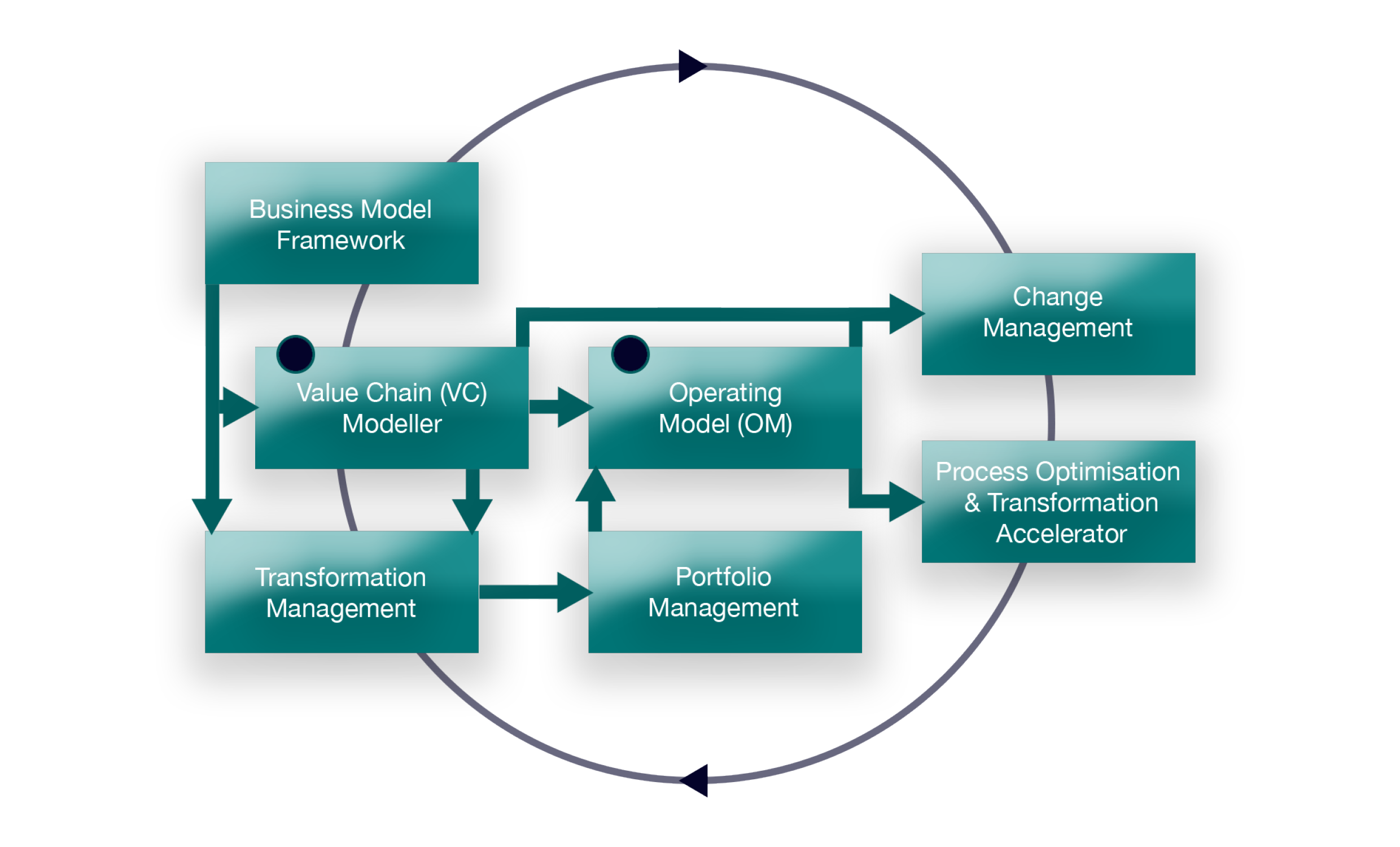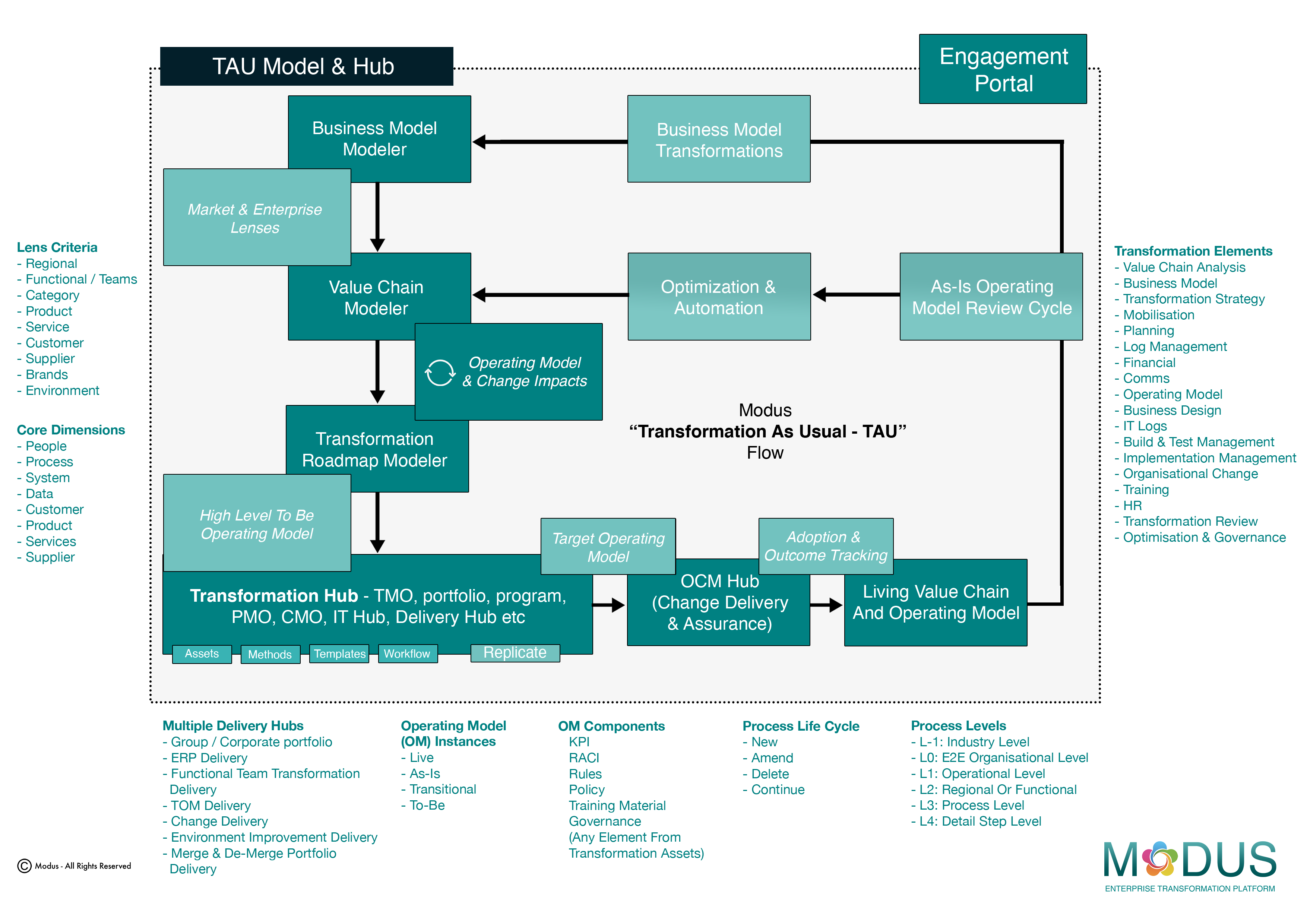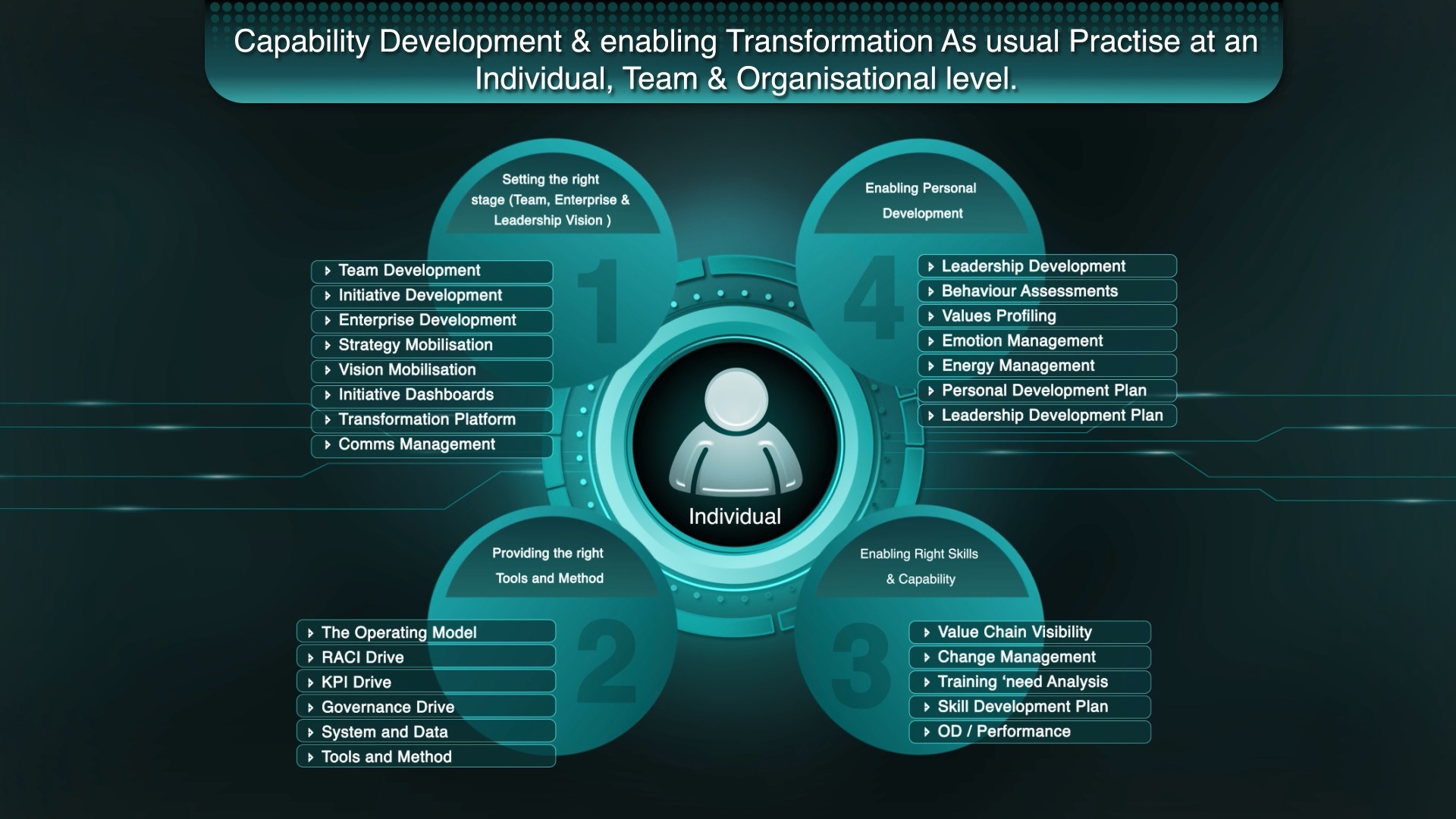Modus Enterprise Transformation Platform (ETP) Overview
The Enterprise Transformation Platform for centralising, controlling and embedding 'Transformation As Usual' throughout organisations.
Transformation As Usual (TAU) Hub and Core Transformation Features
Any seasoned Transformation professional is likely to agree (at least in private) that transformation is something of a super-human task because of its inherent complexity. Understandably, many resort to program and project management solutions (PPM) to try to establish and hold all the threads together, including activities, time, cost and risk. But this still does not link and manage the customer, product, market, financial, systems and organisational interdependencies in one multi-faceted masterpiece. It does not visualise, link and express these in value chains and operating models so that the resultant agenda for change defines every input, output and cause-and-effect logic.
The key driver of success is the degree to which you can achieve true centralisation and integration between thousands of moving parts across all initiatives and projects to deliver the required changes to business and operating models.
In other words, ensuring that every aspect of each dimension is connected in terms of impact logic (cause and effect), mapped onto, and linked with, methods, processes, resources, ways of working and capabilities. If this is omitted or poorly executed, failure is written into the transformation from day one. Fail to plan (absolutely every element) – you plan to fail! The risk of everything falling apart progressively is in direct proportion to the quality of that initial integration.
Modus ETP provides a hub that acts as a focal point for transformation delivery and ongoing optimisation and change. A portal to the collective knowledge and change resources that will enable an organisation to build and sustain its transformation ecosystem and competence over time - we call it 'Transformation as Usual - TAU'.
Modus Transformation As Usual Introduction
In any Business sector we must respond to the need for ongoing change (call it transformation as usual – TAU), and therefore the organisation needs to be ‘change capable’ and ‘change oriented’. This requires quick, easy access to every facet of models, processes, training, documentation, and ways of working that we have created in your original transformation. In other words, a knowledge centre or hub responsive to the need for sustained change. This is a living, breathing foundational ecosystem designed to flex and change with need as the business and operating models respond to the ever-present forces of external disruption.
Modus Framework
Building Transformation As Usual (TAU) Practice using the Modus Framework

• Customer
• Process
• People
• Corporate
• SBU's
• Regional
• Brands
• System
• Data
• Functional/Teams
• Product/Category
• Services
• Environment
• Supplier
Modus Component
Transformation As Usual Capability Model

"Transformation As Usual - TAU" model facilitated by the Modus Enterprise Transformation Platform (ETP). This methodology is designed to systematize the transformation process within organizations, encompassing various stages and tools for comprehensive management and execution. Here's a breakdown of the key components and their functions as depicted in the diagram:

1. Business Model Modeler
• Purpose: Helps in designing and
adjusting business models according
to strategic needs and market
demands.
• Connection: Feeds into the Business
Model Transformations for refining and
optimising business strategies.

2. Value Chain Modeller
• Purpose: Analyses and designs value
chains that are aligned with the
business model.
• Connection: Links directly to the
Operating Model & Change Impacts,
ensuring that changes in the value
chain reflect in operational practices.

3. Transformation Roadmap Modeler
• Purpose: Creates detailed roadmaps
for transformation, outlining key steps,
expected outcomes, and timelines.
• Connection: Feeds into the
Transformation Hub which manages
various transformation projects across
the organisation.

4. Optimisation & Automation
• Purpose: Focuses on enhancing
efficiency through automation and
optimising business processes.
• Connection: Interacts with the As-Is
Operating Model Review Cycle to
integrate improvements and automate
existing processes.

5. Operating Model & Change Impacts
• Purpose: Assesses the impact of
changes proposed in the value chain
and business models on the operating
model.
• Connection: Links changes to the
Target Operating Model to ensure they
are feasible and aligned with
organisational goals.

6. Transformation Hub (Including TMO, Portfolio, Program, PMO, CMO, IT Hub, Delivery Hub)
• Purpose: Acts as the central command
for all transformation activities,
coordinating across multiple projects
and departments.
• Connection: Drives the transformation
through the entire organisation,
utilising the transformation roadmap.

7. OCM Hub (Change Delivery & Assurance)
• Purpose: Ensures that change
management processes are robust
and adhered to, overseeing the
adoption and tracking of outcomes.
• Connection: Supports the Adoption &
Outcome Tracking to measure the
success and effectiveness of the
transformation efforts.

8. Target Operating Model
• Purpose: Represents the future state
of the operating model towards which
the transformation efforts are directed.
• Connection: Guides the transformation
efforts, ensuring that they align with
the strategic vision of the organisation.

Additional Elements:
• Engagement Portal: This interface
facilitates interaction and engagement
across the organisation, supporting the
transformation journey.
• Methodology and Assets: Includes
various methods, templates, and
workflows that are standardised and
replicated across the platform to
support the transformation process.
This methodology ensures that transformations are systematic, integrated, and aligned with both current operational needs and future strategic goals, facilitating continuous improvement and adaptation in an ever-evolving business environment.
Individual and Team Capability Development

The diagram showcases a framework for organizational capability development to enable "Transformation As Usual Practice" at individual, team, and organizational levels. Here's why it's important to have all four quadrants for successful transformation:

1. Setting the Right Stage (Quadrant 1)
Focus:
Team, enterprise, and leadership vision development.
Elements:
Include team development, enterprise development, strategy mobilization, and communication management.
Importance:
This quadrant is foundational, setting strategic direction and aligning the entire organisation with common goals. It's crucial for establishing the vision and the roadmap for transformation.
2. Providing the Right Tools and Method (Quadrant 2):
Focus:
Operational excellence and governance.
Elements:
Emphasise the operating model, governance frameworks, KPIs, and system and data integration.
Importance:
This quadrant ensures that the organization has the necessary tools and methodologies to execute the strategy effectively, enabling consistent and efficient operations across the transformation journey.


3. Enabling Right Skills & Capability
Focus:
Skill and capability development for adaptability and sustainability.
Elements:
Include value chain visibility, change management, training needs analysis, and performance management.
Importance:
Building and enhancing capabilities across the organization ensures that employees are prepared to manage and sustain change, which is critical for the ongoing success of the transformation effort.
4. Enabling Personal Development
Focus:
Individual growth and leadership development.
Elements:
Cover leadership development, behavior assessments, emotion and energy management, and personal development plans.
Importance:
Focuses on personal growth and development, ensuring that leaders and employees are not only equipped with the skills needed for transformation but are also resilient and adaptable to change.

Importance of the Framework:
Having a balanced approach that incorporates all four quadrants ensures that the transformation is holistic and sustainable. Each quadrant supports and reinforces the others, leading to a comprehensive and integrated transformation strategy that addresses the needs of individuals, teams, and the entire organisation. This holistic approach ensures that transformations are not only implemented effectively but are also deeply embedded into the organisation's culture and operations, leading to lasting change and continuous improvement.

